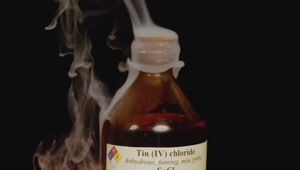Tin(IV) chloride
 Tin(IV) chloride fuming in air
| |
| Names | |
|---|---|
| IUPAC name
Tin(IV) chloride
| |
| Other names
Stannic chloride
Tetrachlorostannane Tin tetrachloride | |
| Properties | |
| SnCl4 | |
| Molar mass | 260.50 g/mol (anhydrous) 350.60 g/mol (pentahydrate) |
| Appearance | Colorless fuming liquid |
| Odor | Acrid |
| Density | 2.226 g/cm3 (anhydrous) 2.04 g/cm3 (pentahydrate) |
| Melting point | −34.07 °C (−29.33 °F; 239.08 K) (anhydrous) 56 °C (133 °F; 329 K) (pentahydrate) |
| Boiling point | 114.15 °C (237.47 °F; 387.30 K) |
| Reacts | |
| Solubility | Soluble in acetone, benzene, CS2, CCl4, chloroform, ethanol, gasoline, kerosene, methanol, toluene, xylene |
| Vapor pressure | 2.4 kPa |
| Hazards | |
| Safety data sheet | Sigma-Aldrich (anhydrous) Sigma-Aldrich (pentahydrate) |
| Flash point | Non-flammable |
| Related compounds | |
| Related compounds
|
Tin(II) chloride |
| Except where otherwise noted, data are given for materials in their standard state (at 25 °C [77 °F], 100 kPa). | |
| Infobox references | |
Tin(IV) chloride, also known as stannic chloride, is a compound of tin and chlorine with the formula SnCl4. Despite what the name implies, it is not an ionic salt that contains Sn4+ ions, but a covalent compound containing covalent Sn-Cl bonds (this is, in fact, typical for high oxidation state metal halides). Because of this, it has a much lower melting point than typical metal chlorides, and is a colorless liquid at room temperature when anhydrous.
Contents
[hide]Properties
Chemical
Anhydrous tin(IV) chloride fumes in humid air forming a white smoke of tin(IV) oxide and hydrogen chloride.
- SnCl4 + 2H2O —> SnO2 + 4HCl
When the anhydrous species is added to liquid water, it reacts exothermically and forms white crystals of the pentahydrate. Anhydrous tin(IV) chloride is a lewis acid, and is a very useful precursor to organotin compounds.
Combined with strong HCl, a hexachlorostannic acid (H2SnCl6, a strong acid) solution is formed. With potassium and ammonium cations this forms soluble hexachlorostannates but the Rb and Cs salts are essentially insoluble, offering a partial route of separation of these elements.
Physical
In the anhydrous state, tin(IV) chloride is a colorless liquid that fumes in contact with humid air. It has a melting point of -34.07°C and a boiling point of 114.15°C. The pentahydrate is a white, crystalline solid. Similarly to aluminium chloride, the anhydrous version isn't obtainable by heating the hydrate, as it decomposes, releasing hydrogen chloride and leaving tin(IV) oxide behind.
Availability
Tin(IV) chloride can only be purchased form chemical suppliers, as it doesn't currently have any uses other than as a chemical reagent. Depending on the country, it may be somewhat hard to acquire.
Preparation
Tin(IV) chloride can be prepared in a home lab setting in a few different ways.
Reaction of tin and chlorine
Tin will react with dry chlorine gas to produce anhydrous tin(IV) chloride. The reaction is very exothermic. Chlorine gas is led from a chlorine generator through a drying tube filled with calcium chloride, or a gas washing bottle containing concentated sulfuric acid. It is then passed over the tin metal. It will react readily with chunks of tin, although higher surface area tin powder would react faster. A flask containing sodium hydroxide is used to absorb excess chlorine gas that doesn't react with the tin. It is recommended that an empty trap vessel is placed between the reaction chamber and the sodium hydroxide to prevent suckback into the reaction vessel.
Pyrolysis of potassium hexachlorostannate
Potassium hexachlorostannate (K2SnCl6), which can be prepared by dissolving tin in aqua regia and adding potassium chloride to the heated solution. Cooling this solution causes rapid crystallization of the K2SnCl6. Strongly heating this salt causes it to decompose into tin(IV) chloride and potassium chloride.
- K2SnCl6 —> 2KCl + SnCl4
The tin(IV) chloride boils off and can be condensed.
Oxidation of tin(II) chloride
Hydrated tin(IV) chloride can be prepared by oxidizing tin(II) chloride in solution using potassium nitrate. This is not a practical procedure for obtaining the anhydrous compound, only the pentahydrate.
Projects
- Make organotin compounds
Handling
Safety
Anhydrous tin(IV) chloride produces very irritating and corrosive fumes in air, and should be used in a fume hood or at least a very well ventilated area. These precautions do not apply to the pentahydrate.
Storage
Anhydrous tin(IV) chloride should be stored in an air tight container to prevent it from reacting with moisture in the air. The pentahydrate can be stored as a general compound.
Disposal
Tin(IV) chloride should be neutralized with a base, and the resulting tin hydroxide should be either recycled or taken to a disposal center.
References
Relevant Sciencemadness threads
- Small scale preparation of Stannic Chloride (SnCl4) (Describes both procedures for producing anhydrous tin(IV) chloride, with pictures)